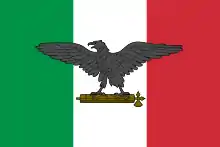National Republican Guard (Italy)
The Italian National Republican Guard (Guardia Nazionale Repubblicana, or GNR) was a gendarmerie force of the Italian Social Republic created by decree on December 8, 1943, replacing the Carabinieri and the National Security Volunteer Militia (MVSN). General Renato Ricci appointed as its commandant. Major General Italo Romegialli was appointed vice commandant and Major General Nicolò Nicchiarelli became the chief of general staff.
| National Republican Guard Guardia Nazionale Repubblicana | |
|---|---|
 GNR Insignia | |
| Active | 1943–1945 |
| Country | |
| Type | Gendarmerie, Militia |
| Size | 140,000 |
| Garrison/HQ | Rome (before June 4, 1944) Brescia (after June 4, 1944) |
| Engagements | World War II |
| Commanders | |
| Notable commanders | Renato Ricci Benito Mussolini |
| Part of a series on |
| Fascism |
|---|
 |
|
The GNR included former Carabinieri, MVSN militiamen, police officers, and members of the Italian African Police (PAI). While being an autonomous armed force before August 1944, on August 15, 1944, the National Republican Guard became a part of the army of the Italian Social Republic. However, it continued carrying out security tasks behind the lines and provided aid to German forces. On August 21, 1944 Benito Mussolini assumed direct command. On August 23, 1944 a separate division, GNR Division Etna, was formed in Brescia under the command of General Violente, to perform anti-paratrooper and anti-aircraft duties. Another division, GNR Vesuvio, was later formed.
Organization of the GNR
- 1 headquarters Command
- 18 regional Inspectorates
- 94 provincial Commands
- 94 Legions
- 12 independent battalions
- GNR - 'Mazzarini' GNR Parachute battalion of 300 men. It mainly operated against Italian partisans in the Po Valley from August 1944 until 1945.
- 82 companies
- 5 motorized battalions
- 3 squadrons
- 1 school centers
- 2 officers Cadet schools
- 2 NCO schools
- 7 specialist police schools
- 1 arsenal
- 4 clothing and equipment stores
- 2 clothing procurement and issue facilities
- 1 band
Special military services of the GNR

The GNR had following Special military services:
- 1. Railway GNR, of 9 legions
- 2. Harbour GNR, of 3 legions
- 3. Post and Telegraph GNR, thirty small units
- 4. Mountain and Forests GNR, of 7 legions
- 5. Frontier GNR, of 5 legions
- 6. Highway GNR, many small units (traffic and highway patrol duties)
Disarming of ex-Carabinieri
In August 1944, once Germany understood that MVSN were in the minority and that military ex-Carabinieri tended to join guerrilla partisans, the country decided to disarm and arrest the Carabinieri. Of the 11,000 Carabinieri still in service in the summer of 1944, 3,000 were sent to Germany before combing and equally few were conducted over the Alps in the aftermath. After August 25, 1944, only 1,400 Carabinieri remained employed as either service workers or military bureaucrats.
Reorganization

Following the disarmament of the Carabinieri, the GNR faced a deep crisis due to its smaller size: 35,000 troops for the territorial units, 11,000 between Guard Youth and students, and fewer than 5,000 for independent training. The weakening of the GNR also occurred through territorial governance reorganization. Most local districts previously served by Carabinieri had been dissolved. By September 1944, the Italian Social Republic's control over its territory was no longer as effective as it had once been. Eventually, a reorganization of GNR occurred through[1] a strengthening of territorial departments, while schools were established for officers.
The Republican Guard Youth was renamed Guard Youth Legionaria, with the transformation of assault battalions legions and training centers. The newly established centralized department was named Etna Division, which coordinated the department used in Germany in FlaK (anti-aircraft) and anti-partisan departments employed by General Karl Wolff. The Etna Division absorbed, as a result, nine battalions of assault youth (for air defence) and October five operating divisions, four battalions and an assault battalion paratroopers.
The only autonomous departments that remained were the Legion M Guardia del Duce, the Legion Tagliamento M, the Leonessa armored group, and Legion Carmelo Borg Pisani.[2]
Soldiers of the GNR were apparently posted to the German 65th Infantry Division in the winter of 1944-45 as replacements for the 1st Battalion of Grenadier Regiment 145.[3]
Ranks
Officers
| National Republican Guard | English | Insignia |
|---|---|---|
| Generale | General |  |
| Tenente Generale | Lieutenant General |  |
| Maggior Generale | Major General |  |
| Colonnello | Colonel |  |
| Tenente Colonnello | Lieutenant Colonel |  |
| Maggiore | Major | |
| Capitano | Captain | |
| Tenente | First Lieutenant | |
| Sottotenente | Second Lieutenant |
Status of legitimate combatants
Postwar
With the end of the war the Italian troops fighting in the service of CSR were considered formed by Italian citizens who served militarily classified "military aid to the enemy" or "aid the enemy in his political plans" and therefore responsible for crimes punishable under the existing Military Code of Procedure of war thereby excluding these citizens could be considered military conflict, because to be considered somewhat rebellious against the legitimate state consisting of the Southern Kingdom, representing the legal continuity of the Italian State and recognized as such at the time well as from allied countries, including the majority of neutral nations.[4]
Discrimination of CSR combatants was sanctioned by Legislative Decree March 4, 1948, n. 137. The Supreme Court, including the United Sections, has always considered legitimate in the sense that a long list of convictions for crimes of military aid to the enemy (Article 51 C. p. mil. War) and aid to the enemy in his designs Political Rights (art. 58). However, with the ruling of April 26, 1954 No 747, the Supreme Military Court "recognized the soldiers of the Italian Social Republic (RSI) the status of military combatants," denying, however, back to the partisans.
Proposals of law
With specific reference to that single sentence, in the fourteenth term in the Senate was presented the draft Law 2244 ("Riconoscimento della qualifica di militari belligeranti a quanti prestarono servizio militare dal 1943 al 1945 nell'esercito della Repubblica sociale italiana" or "Qualified military conflict to those military service in the Army from 1943 to 1945 the Italian Social Republic"). It since its introductory report - and then report to the House - revolved around the formal data on which it based its decision No. 747 del 1954: The Hague Conventions and Geneva, under which it can not be apart from the "principle of equality between the warring parties," according to which the law of war applies to both the aggressor as aggression, both equal before the laws of war. Text provoked an uprising by the political opposition to the government of the time and by the 'ANPI and was eventually abandoned.
Starting from a proposal made by President Carlo Azeglio Ciampi, which provides a recognition on the model of the Knights of Vittorio Veneto fighters framed in the forces in the Italian Army during the 2nd World War, in the sixteenth legislature the bill n. 11360, 23 June 2008 has taken a more egalitarian than that presented in the previous XIV legislature, intending to give equally to all participants in the Second World War - fascist or not - "a similar recognition to that conferred by law March 18, 1968 No 263 fighters of the 1914-18 war. To this end, Article 1 of the bill establishing a new order of honor, the Order of the Tricolor, which includes the only class of Knight. The new award was to be awarded:
- to all those who have served the military for at least six months, even several times in the area of operations in the Italian armed forces during the 1940-45 war and military invalids or training or Gappisti regularly framed in partisan formations dependent Corps volunteers freedom;
- fighters of the war 1940-45;
- the maimed and disabled war pensioners 1940-45 war;
- to former prisoners or interned in concentration camps or prison;
- fighters in the formations of the national Republican during the two years 1943-1945;
Providing for the payment of a living allowance to the survivors and presence on the board of regents of the Order, along with military representatives of republican institutions, associations and the president of the veterans 'Partisans of the President' s Historical Institute of the Italian Social Republic.
Moreover, the same National Union Veterans of the Italian Social Republic (Unione Nazionale Combattenti della Repubblica Sociale Italiana), as a claimant the status of combatants, "legitimate unlike the partisans," he declared its disinterest in the draft law.[5]
The bill, as a consequence of the invitation addressed to the consistency publicly Dario Franceschini to Silvio Berlusconi after the speech commemorating the resistance held by the latter to Onna on April 25, has been withdrawn by the petitioner, the deputy Lucio Barani, on April 28, 2009.
Notes
- the Armed Forces of CSR-Pier Paolo Battistelli, Andrea Molinari, p.122
- The Armed Forces of CSR-Pier Paolo Battistelli, Andrea Molinari, p.123.
- Velten, Wilhelm. Vom Kugelbaum vor Handgranate, p.177
- Art 5 of Legislative Decree Lieutenant of the Realm July 27, 1944 159 replacement of the previous Royal Decree-Law May 26, 1944 No 134), which punishes according to the provisions of the Military Penal Code any person who has committed or is committing war crimes against the loyalty and protecting the state's military, in any form of intelligence or correspondence or collaboration with the German invader, aid and assistance it provided. In particular we can cite the sentence within the maximum permitted in our legal system, the resolution of a conflict of jurisdiction by the United Sections criminal, on 7 July 1945 (chairman and rapporteur Aloisi, pg closure in accordance with Lattanzi), is ruled to the contrary to the clear recognition of "belligerency" of the military fascist Republicans.
- National Congress of the Union, celebrated in Latin 3 and 4 April 2009



